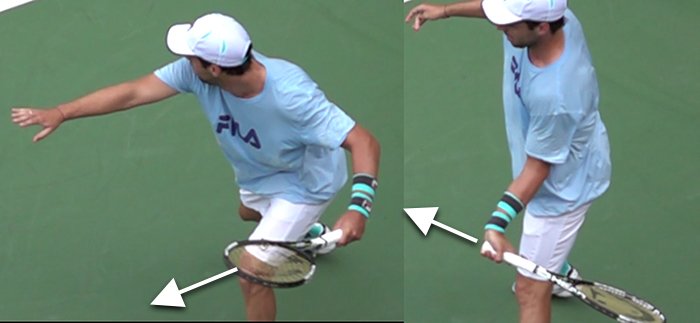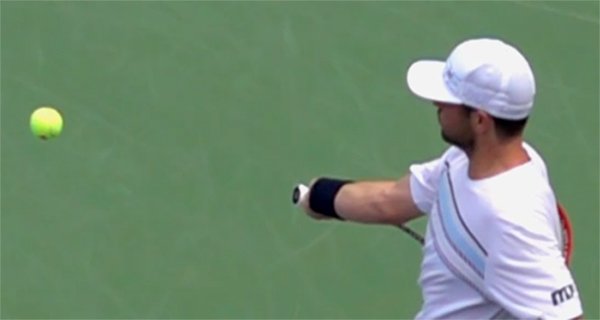The Dynamic Pull and Elasticity
The modern forehand is all about generating big and powerful topspin. And the secret to generating topspin lies in the dyanmic and elastic forearm muscles that get pulled, stretched, and released just before contact when the windshield wiper motion takes over. In my last article, I used my latest high speed video to show how the hand twists backwards and downwards as if you are "turning a doorknob". And then just before contact, you turn the doorknob in the other direction, gripping the ball and turning it like you are "twisting open" a tightly sealed jar. In this article, I want to show a rather extreme version of how pro players start pulling the racket forward to really build up tension and elasticity in the forearm muscles to help propel the racket forward and upward into contact. I call this the "dynamic pull", and it is the secret to generating topspin using the windshield wiper technique that dominates the pro game today.
The player above starts with his racket pointing straight to the side fence. As he starts to pull the racket forward, he simultaneously starts twisting the hand backwards and downwards below the ball. The farther he pulls forward the farther his hand twists backwards until he is fully "in the slot". At this point, his forearm muscles are fully stretched, like a rubber band, ready to spring forward. This is technically referred to as the "stretch shortening cycle", which has been referred to as a "supercharged rubber-band effect," enabling us to produce more force once the muscle has been stretched than from a standstill (click here).

In the stills above, you can see just how quickly this dynamic pull occurs. It's a burst movement with the hand pulling first while the racket whips backwards a full 90 degrees and gets dragged forwards, causing a dynamic stretch of the forearm muscles.
Mardy Fish offers a perfect example of the "dynamic pull". He starts with his racket pointed towards the right sideline. As he starts pulling forward, with the racket in this position, his wrist begins twisting backwards and downwards. The racket is not only being pulled forward, but the hand is twisting backwards while the forearm muscles get pulled and stretched from the forward pull.

Moments before contact the butt cap is pointing straight at the ball and the forearm muscles are fully stretched, waiting to spring the wrist and racket forward and upward into the ball. Notice just how far Mardy has pulled the racket forward while still having the racket completely stretched backwards. This leads to a wonderfully leveraged contact point and maximum stretch of the forearm muscles.
Two of my favorite regular high speed examples of this dynamic pull are Treat Huey - a top ranked doubles player from the Philippines - and Mischa Zverev. Both players wonderfully demonstrate this extreme dynamic pull in action. Mischa actually starts with his racket pointing more towards the net as he starts his pull forward. The backwards rotation of the hand as he pulls forward is incredible.
These examples are all extreme examples because the players start with their rackets pointed sideways as they begin to pull forward, which exaggerates the backward stretch of the wrist. But it's a great movement to copy if you are trying to develop this feeling in your own forehand.
Start with your racket pointed to the sideline. Then start to pull your arm forward as you twist your wrist backwards and downwards. Feel the stretch of your forearm muscles as your pull forward. And moments before contact let the elastic rubber band fire which will cause the racket to spring forward and upward in torquey motion that will let you grip and turn the ball in a windshield wiper path.
Next we will look at this same dynamic pull, but in its more subtle version. The racket doesn't start facing the sideline, but the same dynamic occurs with pre-stretch of the forearm muscles and the springing forward and upward just before contact.
